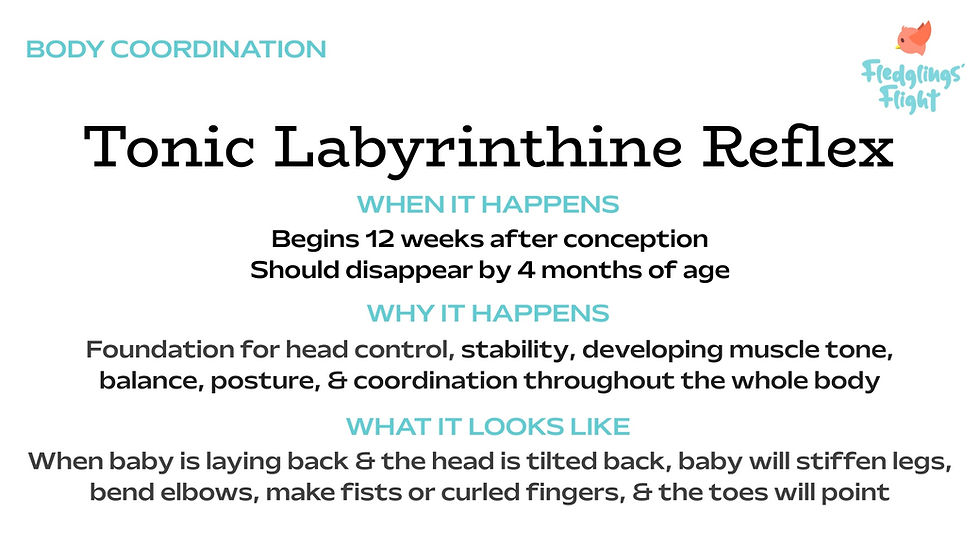Holding On: How the Palmer Grasp Reflex Prepares Babies for using their Hands
- Kaylie Estrada
- Sep 9
- 3 min read
Updated: Sep 30
The Palmer Grasp Reflex makes your baby’s hand close when their palm is touched.

What are primitive reflexes?
Primitive reflexes are instinctive movements that babies are born with. They begin developing before birth and prepare infants for life in the outside world. These automatic responses are nature’s way of helping babies survive, grow, and slowly lay the foundation for movement, coordination, learning, and eating. Over time, each reflex fades away as voluntary control takes over, making room for all their learned skills.
Different primitive reflexes each serve a unique purpose. There are many that range from in helping with feeding, mobility, body coordination, and even self-preservation. The Palmer Grasp Reflex, which we’ll focus on here, is an early reflex that helps babies learn to grip and hold with their hands. Together, these reflexes help babies adapt to their environment and build the foundation for more complex movement and learning.

What is the Palmer Grasp Reflex?
The Palmer Grasp Reflex is one of the first reflexes to appear, and begins to develop around 16 weeks after conception. It can be seen when you place your finger or another object in your baby’s palm. Their little hand will automatically respond by closing around it. This reflex teaches babies the first steps of gripping and holding, which are skills that will later turn into using utensils, holding toys, and eventually writing.
This reflex also supports the development of fine motor control by connecting the touch sensation in the hand to the brain. The reflex usually disappears by about six months of age, as babies gain the ability to open and close their hands on their own and intentionally grasp objects. Watching a baby wrap their fingers tightly around yours is not only adorable, but it is also a sign of important neural and muscular development taking place.

What happens if the Palmer Grasp Reflex Lingers?
If the Palmer Grasp Reflex stays active after six months, it can interfere with both physical skills and learning. As the National Library of Medicine explains, “...the absence or persistence of the Palmar Grasp Reflex beyond the expected age can be an important clinical indicator of neurological dysfunction,” [4]. Children with a lingering reflex may struggle with tasks requiring fine motor control, such as holding a pencil correctly or tying their shoelaces. Since the motor and language systems are closely connected, a lingering Palmer Grasp Reflex is also associated with messy handwriting, poor spelling, and difficulty organizing thoughts on paper. Some children may experience posture problems when sitting, or even challenges with speech and vision coordination. Emotional regulation can also be affected, sometimes showing up as frustration or anger control issues. Normally, as the reflex fades, babies gain the strength and voluntary muscle control needed to support their hands during more precise movements. Monitoring their progress is always important.

How to test for a retained Palmer Grasp Reflex
You can test for this reflex by gently pressing your finger into your baby’s palm. If the reflex is active, your baby’s hand will automatically close tightly around your finger. This is the normal reaction for an infant under six months. It shows that their nervous system is working as it should. However, if you notice that your child is still automatically grasping well after the six month mark, the reflex may not have fully integrated. At this point, it’s worth paying attention to how they use their hands during play and everyday activities.

What can you do about a retained Palmer Grasp Reflex?
If you think your child’s Palmer Grasp Reflex is lingering, awareness is the first step. Talk to your pediatrician, who may refer you to an occupational therapist or developmental specialist for further evaluation. Therapies and simple exercises can help integrate the reflex and strengthen voluntary hand control. This will help set the foundation for improved fine motor skills, and learning. Early support is key; addressing retained reflexes can help children build confidence, and navigate their world much easier!
Sources:
Lewis, R. (2020, May 19). What are the primitive reflexes and how are they useful? Healthline. https://www.healthline.com/health/baby/primitive-reflexes?utm
Brain Balance Centers. Retained Primitive Reflexes as a Sign of Brain Imbalance. https://www.brainbalancecenters.com/blog/retained-primitive-reflexes-sign-brain-imbalance
Understanding Primitive Reflexes: A Dynamic Perspective on Sensory Motor Development. (n.d.). Sensory Health. https://sensoryhealth.org/node/2060
Falkson, S. R., & Bordoni, B. (2025, January 22). Grasp Reflex. StatPearls - NCBI Bookshelf. https://www.ncbi.nlm.nih.gov/books/NBK553125/

Want more information like this?
Create a free account with Fledglings' Flight and get access to 4820 screen-free, play-based exercises. That is 100-200 exercises each month that you can start doing with your baby from the day that they are born to help them to develop into the best version of themselves. In addition, your free account gives you access to 1200+ articles on child development to keep you informed while you help to navigate your child's developmental journey.




Comments